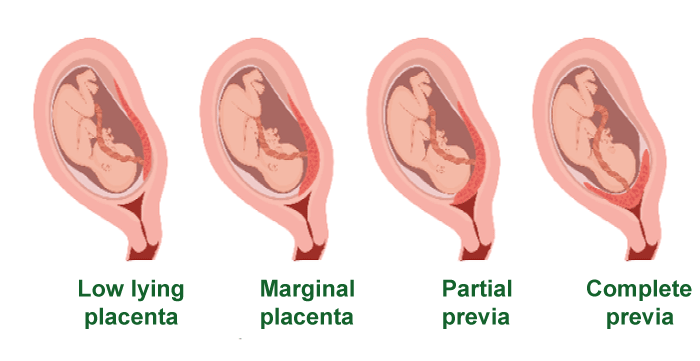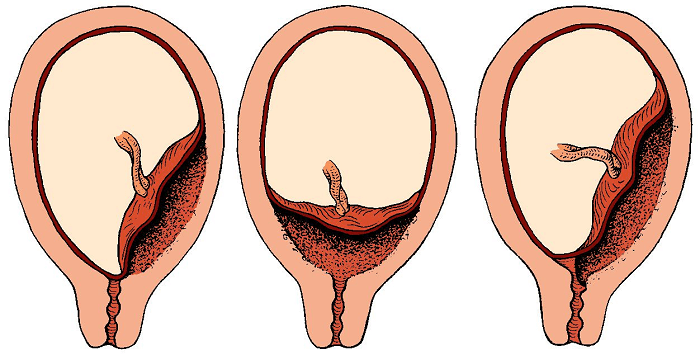Placenta Previa DefinitionPlacenta is an organ that nourishes the foetus at the time of pregnancy. When the placenta is located in the lower part of the uterus, it results in a condition called placenta previa. In this condition, the placenta partially or completely covers the cervix. As a result, women may suffer from bleeding at the time of pregnancy and may require some medical help. At the time of routine prenatal ultrasound, the condition is diagnosed, and treatment starts. The treatment depends largely on factors like the mother's health and the gestation age of the foetus and also on the severity of the condition. The treatment mainly involves medication, bed rest, and delivery of the child by caesarean section. 
Definition of Placenta PreviaThe condition in which the placenta either partially or wholly covers the cervix of the mother is called placenta previa. Due to this condition, the mother faces excessive vaginal bleeding, and sometimes it may also turn life-threatening for both the mother and the baby. Different Types of Placenta PreviaThere are three types of placenta previa. They are based on the location of the placenta covering the cervix.
It is very important to understand that placenta previa is not a very common condition occurring in pregnant women. It only occurs in around 0.5 to 1% of women in the world. But there are certain factors that may increase the risk of developing placenta previa. For example, previous delivery of the baby through caesarean section, maternal age (older women), smoking during pregnancy, and multiple pregnancies are some of the factors that can increase the risk. Causes and Risk Factors of Placenta PreviaAlthough the exact cause of the condition is still unknown, it is known that the cause of placenta previa is somehow related to the way in which the placenta attaches itself to the uterine wall during the initial phase of the pregnancy. During normal pregnancy, the placenta is attached to the upper part of the uterus, which is quite away from the cervix. However, in the case of placenta previa, the placenta somehow gets attached to the lower part of the uterus; therefore, the cervix is completely or partially. 
Risk Factors of Placenta PreviaThere are several risk factors involved with placenta previa. Some of them are:
One thing to note here is if a woman shows one or more of these risk factors does not mean that she will surely develop placenta previa during her pregnancy. There are cases where women, even without showing any risk factors still be diagnosed with the condition. In order to reduce the complication, a mother should undergo regular prenatal check-ups and ultrasounds. It can help doctors to detect the condition early and reduce the severity of the condition. Symptoms of Placenta PreviaSome of the most common symptoms of placenta previa are:
One thing to note here is that some women with the condition may not experience any symptoms at all. DiagnosisDuring prenatal checks and regular ultrasounds, it is easy to diagnose placenta previa. It is usually diagnosed between the second and third trimester of the pregnancy. Ultrasound helps in determining the position of the placenta relative to the cervix. If it is found in the ultrasound that some part of the cervix or the whole cervix is covered by the placenta, then doctors will recommend a follow-up ultrasound. This follow-up ultrasound is recommended to check if the placenta is naturally removed from the cervix or has moved on its own. In some cases, the doctors may recommend some additional imaging tests like Magnetic Resonance Imaging (MRI) scan to understand the condition in a better way. If a woman experiences vaginal bleeding at any time during her pregnancy, she should consult her doctors as soon as possible. The doctors may suggest a pelvic test or other examinations like a fetal non-stress test or a biophysical profile. These tests help the doctors understand the condition more clearly to determine the cause of the bleeding and also assess the health of the fetus. If, by any means, placenta previa is diagnosed, the doctors may ask the mother for hospitalization or simply bed rest, depending on the situation of the mother and the baby. The treatment goes until the bleeding stops or sometimes until the delivery of the baby is safely taken out. Complications Associated with Placenta Previa
Depending on the severity of the condition and the type of placenta previa, the complications can vary from mother to mother. Sometimes, the bleeding caused by placenta previa can be life-threatening for both mother and the child. If the bleeding gets unnoticed and uncared for, it can later on become heavy and may require emergency medical treatment. The other complication a mother faces while she is suffering from placenta previa is preterm labor. In this case, the cervix starts dilating prematurely. As a result, the uterine wall will start experiencing contractions which will lead to the premature birth of the baby. Premature birth in itself is not such a safe situation. It increases the risk of other complications for the baby, like respiratory distress syndrome and infections. Another complication associated with placenta Previa is fetal distress. When the placenta covers the cervix partially or wholly, the baby/fetus may not get oxygen and other nutrients in enough quantity. This situation results in a decrease in fetal movements and lower heart rates, and sometimes it can also cause potential stillbirth. In some cases, placenta previa, when it grows too deeply inside the uterine wall, gets associated with placenta accreta. This association causes severe bleeding at the time of delivery, and doctors may suggest a hysterectomy in order to control the excess bleeding. The best way to minimize the risks and complications associated with placenta previa is early intervention and close monitoring. It is done when the mother receives proper prenatal care and take appropriate medical treatments if they experience any symptom like bleeding. Frequently Asked Questions About Placenta PreviaPlacenta previa is a condition in which the placenta is located low in the uterus and partially or completely covers the cervix. This can lead to complications during pregnancy and delivery. Here are some frequently asked questions about placenta previa: 1. How Common Is Placenta Previa?Placenta previa is not very common, occurring in approximately 0.5% to 1% of all pregnancies. However, the incidence of placenta previa increases in women who have had previous caesarean sections or other uterine surgeries. 2. What Are the Risk Factors for Placenta Previa?Risk factors for placenta previa include a history of previous caesarean section or other uterine surgery, advanced maternal age, smoking, multiple pregnancies, and a history of placenta previa in a previous pregnancy. 3. What Are the Symptoms of Placenta Previa?The most common symptom of placenta previa is painless vaginal bleeding in the second or third trimester. Women who experience vaginal bleeding during pregnancy should seek immediate medical attention. 4. How Is Placenta Previa Diagnosed?Placenta previa is usually diagnosed by ultrasound. If placenta previa is suspected, a transvaginal ultrasound may be performed to determine the exact location of the placenta in relation to the cervix. 5. What Are the Risks Associated with Placenta Previa?Placenta previa can lead to complications during pregnancy, such as preterm labor, premature rupture of the membranes, and fetal growth restriction. It can also cause bleeding during pregnancy and delivery, which can be life-threatening for both the mother and the baby. 6. How Is Placenta Previa Managed?The stage at which placenta previa is diagnosed, the type of placenta previa, and the severity of the condition determine how it will be managed. There are cases where doctors suggest simple bed rest to the woman suffering from the condition, and in other cases, doctors may ask for hospitalization. Depending on the type of placenta previa, the type of delivery is determined. 7. If A Mother Develops Placenta Previa, Will It Affect the Mother and The Child In The Long Term?If the condition is managed properly, the long-term effects of placenta previa will not occur, and both will remain safe. But in the case where proper management of the condition is not done, then women having placenta previa will develop the risk of developing placenta accreta. Placenta accreta is a condition in which the placenta starts growing too deeply into the uterine wall. This can lead to excessive bleeding at the time of delivery, and the mother may undergo a hysterectomy. There is a high chance of premature birth in a baby who is born to a mother diagnosed with placenta previa.
Next TopicProcurement Definition
|
 For Videos Join Our Youtube Channel: Join Now
For Videos Join Our Youtube Channel: Join Now
Feedback
- Send your Feedback to [email protected]
Help Others, Please Share










